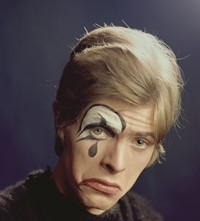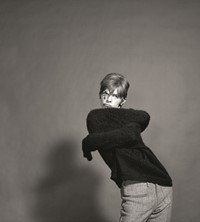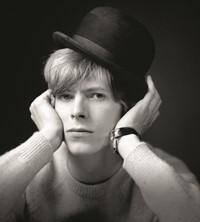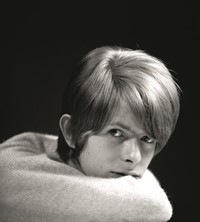On what would have been Bowie’s 72nd birthday, photographer Gerald Fearnley recalls shooting the then-unknown musician
- TextMiss Rosen
In 1967, a young man named David Jones had spent five years trying to make a go as a musician. Hailing from Brixton by way of Bromley, the 20-year old artist decided to change his name, lest he be confused with Davy Jones of the Monkees. Taking the surname of James Bowie, the knife-fighting legend, the newly minted David Bowie decided to release his debut self-titled album, a curious mix of pop, psychedelia, and music hall tunes on June 1 – the same exact day Sgt. Pepper’s Lonely Hearts Club Band dropped.
Inspired by Edwardian flam, the cracked nursery rhymes of early Pink Floyd, the theatrical stylings of Anthony Newly, who penned the title song for Goldfinger, and Tommy Steele, Britain’s first rock and roll star, as Bowie himself told Andy Neill in 2007 for MOJO magazine, “I didn’t know if I was Max Miller or Elvis Presley”.
Bowie had been working with a musician named Derek “Dek” Fearnley, to make the album. Fearnley had a younger brother named Gerald, a working photographer who started with the RAF during the war before specialising in commercial still life work. Gerald was enlisted to shoot the album, and he did the job. The album failed to perform and Decca Studios dropped Bowie from the label.
50 years later, following Bowie’s death, Fearnley went into his archive to unearth a series of photographs, most of which have never been seen before. In Bowie Unseen: Portraits of an Artist as a Young Man (ACC Editions), Fearnley takes us back to this pivotal moment in time to paint an intimate portrait of David Bowie, before he was famous.
“My brother, Derek, known as ‘Dek’, was a musician. He always had his bass guitar with him and played gigs up until he passed away in 2008. But in the 1960s, we were all just starting out with our lives. And by 1966, I had a small home, a wife and three small kids. Dek would often use my place to stay before or after gigs. He would often bring by a fellow musician into our home. No one knew that one of the musicians would turn out to be David Bowie.
“David seemed very serious about what he was doing, he seemed trustworthy. He and my brother would often be in the kitchen writing. He used to play with the children, games of Monopoly or teaching them how to play the penny whistle. David was great with the kids, very pleasant, always polite.
“I had a studio in town, down near Oxford Street, and Dek and his musician friends would come up from time to time. I remember once I was walking either to or from the studio and I heard somebody shout my name from across the street. I looked up and it was David! He had this great big leather coat on, all the way to his ankles. That’s what I remember, he was just an ordinary bloke.
“I don’t remember why I took those photos, probably because I was the only one he knew with a studio and camera. I was as much of a professional photographer as he probably knew back then, but I only did still life photography... I never really followed his career, but my girls all did. They couldn’t believe that he was once just a young kid, sleeping on the sofa and teaching them how to play the theme tune from the TV series The Killing Stones on the penny whistle.”
Bowie Unseen: Portraits of an Artist as a Young Man is available now, published by ACC Editions.















